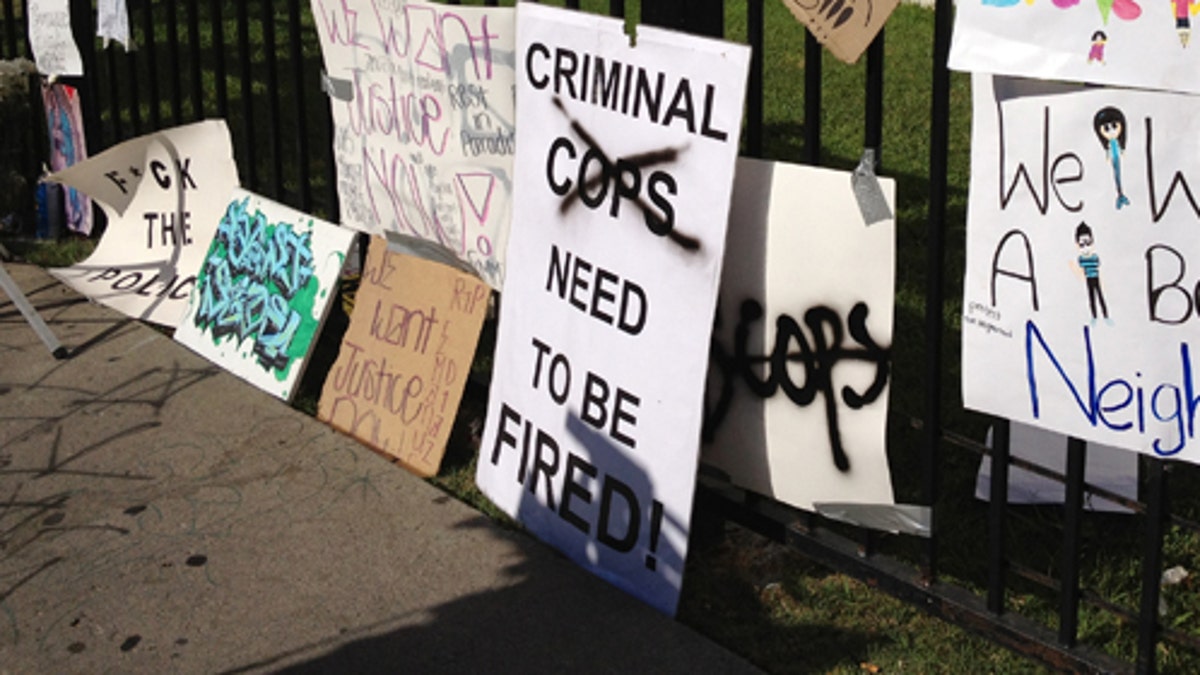
(Photo: Raquel Estupinan)
Anaheim, Calif. – Less than five miles from the “happiest place on earth” is Anna Drive, where last Saturday, police shot and killed an unarmed 25-year old named Manuel Diaz. A memorial outside the apartment complex marked where Diaz died after a gunshot to the leg and then the head. Candles, pictures of the Virgin Mary, posters, and a small donation box made up the memorial. Handwritten posters read, “Criminal cops need to be fired,” and “We want a better neighborhood.” Outside the rows of apartments on the crowded street, adults sat and chatted while kids played on the sidewalk. Diaz’s friends gathered around the memorial.
Residents of Anna Drive acknowledged the crime and the constant patrolling in their neighborhood. “Only at night many people don’t like to be out because there are a lot of gang members, and it’s scary,” said Lorena Barillas in Spanish. “But if you mind your own business, they won’t bother you.”
Beyond the headline-making deaths of Diaz and Joel Acevedo, 21, who police shot and killed Sunday after police said Acevedo fired at them, are what a local activist calls the problems of disenfranchisement and years of the Hispanic community being ignored by the Anaheim City Council. Others accused the police force of racial profiling.
We’ve had good relations, but a lot of the anger and frustration that you’re seeing right now tells me that we need to work on much, much, much better relations.
“Right now there’s a festering anger,” said Joanne Sosa, an activist for Take Back Anaheim. “They’re trying to calm things down, but how can they when their voices were stifled.”
On Tuesday, Sosa organized residents from Anna Drive to rally at a city council meeting, but, she said, when they arrived, the chamber and the steps were already filled, so they didn’t have a chance to speak. Sosa said they were not involved in Tuesday night’s violence.
The areas where Diaz and Acevedo were shot and killed are largely Latino with higher rates of poverty compared to the rest of Anaheim. On Guinida Lane, where Acevedo, who police said was a suspected gang member, died, the neighborhood was quiet Wednesday.
Unlike Anna Drive, residents don’t hang out on their front yards, the streets aren’t crowded, and mostly homes make up this neighborhood; however, data from the American Community Survey show these two neighborhoods have similar demographics.
“This is why we have a problem here. The people in these areas…they’re right in the shadow and the border of Disney,” said Sosa, who previously worked for the Anaheim Chamber of Commerce. “The money from the city always goes to the rich.”
Sosa said she’s been trying to work with the city council to build relationships between residents and their leaders. None of the five city council members are Hispanic, even though they represent a city where about 53 percent of the population is Latino, according to 2010 Census data.
It was slow progress in starting a dialogue with city council members, leaders from a local church, and Police Chief John Welter, when the series of shootings and violent protests occurred, Sosa said.
“The fragile relationships that were being built got absolutely ripped away, raw nerves.”
The relationship between the police and the community is a strained one, if at all existent, according to several Anaheim residents.
“We’ve had good relations, but a lot of the anger and frustration that you’re seeing right now tells me that we need to work on much, much, much better relations,” said State Sen. Lou Correa, who represents Anaheim and acknowledged a gang problem in the city. On Wednesday he was in the downtown Anaheim monitoring the damage to about 20 businesses that resulted from violent protests in the days before.
On the east side of Anaheim, the presence of gangs and a high rate of crime lead to more officers patrolling the area. But residents said that it also leads to racial profiling.
“If you’re Hispanic, you’re bald and wearing a white shirt with baggy pants, you’re more likely to get harassed around here,” said Ricardo Hurtado, 21, a friend of Diaz.
And many echoed Hurtado’s sentiment in Anaheim’s downtown, the site of Tuesday night’s violent protests; still, another disagreed. Resident Kellen Dugan, 28, who served in the Army, said he thinks the police are doing a good job. “There are some areas here that are just super hot. [The police] have a right to be worried.”
In the midst of the marches and uproar and calls from Anaheim city officials for an outside review of police use-of-force, many questions still remain to be answered.
Unlike the city council, Sosa said there is not an issue of inadequate Latino representation in the police department; the real issue, she said, is the fractured relationship between community members and leaders.
“We absolutely need the police. What we’re talking about here…was a young man who was shot …and once he went down…he was shot in the back of the head. That’s an execution. This is what really upsets the people here,” Sosa said.
